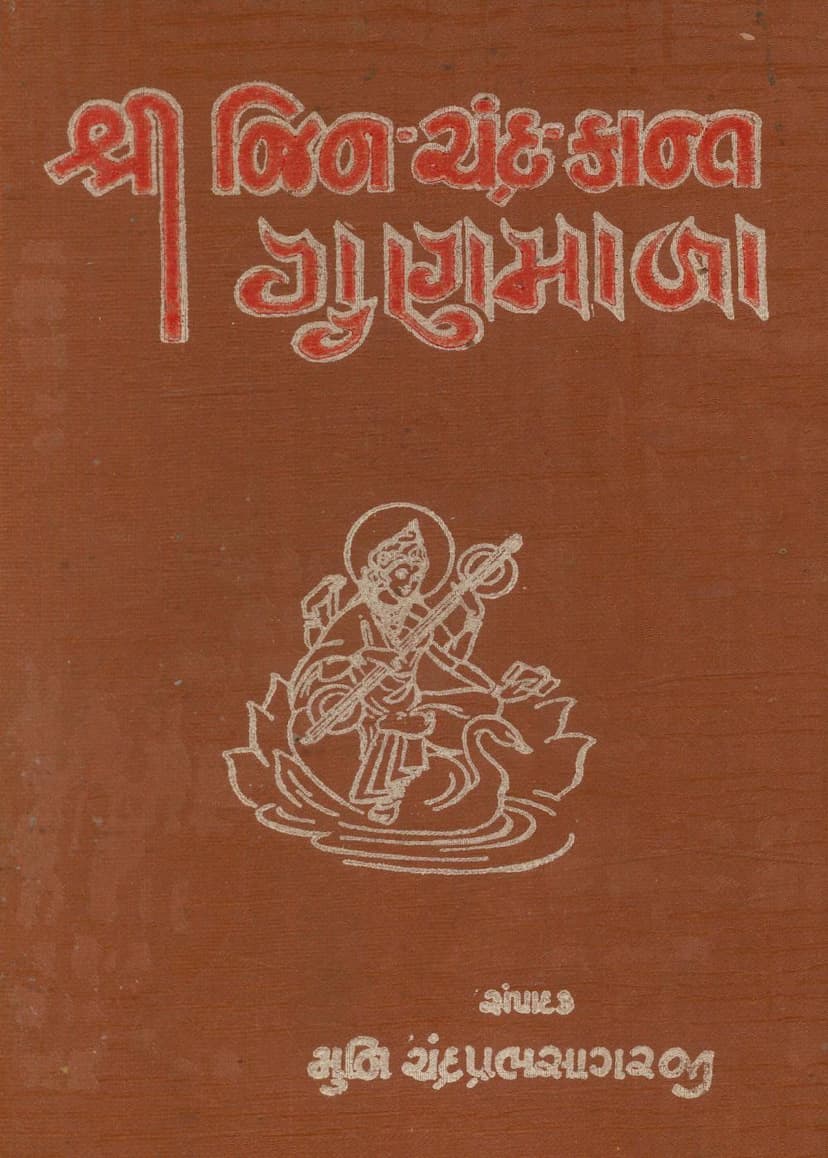Jin Chandra Kant Gunmala
Added to library: September 2, 2025

Summary
Here's a comprehensive summary of the Jain text "Jin Chandra Kant Gunmala" based on the provided pages:
Book Title: Jin Chandra Kant Gunmala Author(s): Chandrakantsagar, Chandraprabhsagar Publisher: Lalbhai Manilal Shah (Shree Jeevan-Mani Sad-Vachanmala Trust)
Overview:
"Jin Chandra Kant Gunmala" is a Jain scripture compiled and edited by the disciples of Acharya Maharaj Shri Chandrasagarsuriji M. – namely, Muni Shri Chandrakantsagarji M. and Muni Shri Chandraprabhsagar M. The book is a collection of hymns, prayers, rituals, and devotional songs (stavan) dedicated to the veneration of Jain Tirthankaras and other significant figures in Jainism. The text also includes a biographical account of Muni Shri Chandrakantssagarji Maharaj, highlighting his spiritual journey and virtuous life.
Key Content and Themes:
-
Editorial and Publication Details:
- The book is presented as a valuable devotional resource.
- It was published by Shree Lalbhai Manilal Shah, associated with the Shree Jeevan-Mani Sad-Vachanmala Trust in Ahmedabad.
- Multiple editions were released in 1955, 1956, and 1960, indicating its popularity and importance.
- The publication is attributed to the request of the Navrangpura Jain Svetambar Murtipujak Sangh, Ahmedabad, underscoring community support.
-
Biographical Tribute to Muni Shri Chandrakantssagarji Maharaj:
- A significant portion of the text is dedicated to honoring Muni Shri Chandrakantssagarji Maharaj, who passed away at the Navrangpura Upashraya in Ahmedabad during Chaturmas in 1959.
- His passing is described as a moment of profound spiritual realization and samadhi-maran (death in meditative state), uttering "Arihant, Arihant" with his last breath.
- The text emphasizes his profound impact and the gratitude felt by the Navrangpura Sangh towards him.
- His desire for the third edition of this book to be published served as an inspiration and a memorial tribute.
- His life is portrayed as simple, disciplined, dedicated to spiritual practices, austerity, and compassion towards the needy.
- His earlier life is also touched upon, mentioning his secular name Chhotalal, his upbringing, his business acumen, his adherence to righteous principles, and the personal tragedies that led him to renunciation and ultimately to take diksha along with his son.
-
Devotional Content and Rituals:
- Prayers and Mantras: The book begins with prayers like "Jay Siddha-Chakrji," "Namo Arihantanam," and praises for the Guru and Saraswati Mata, reflecting core Jain devotional practices.
- Chaitra Vandan Vidhi: Detailed procedures for worshipping in Jain temples (Chaitya Vandana) are provided, including specific stanzas for various Tirthankaras and sacred sites like Shatrunjay.
- Posadh Vidhi: The text outlines the rituals and guidelines for observing Posadh (fasting and strict religious observance), covering daily routines, necessary items, and specific timings for various practices throughout the year.
- Sajzhaya and Stavan: A vast collection of devotional songs (Sajzhaya) and hymns (Stavan) attributed to various revered Jain monks like Shri Anandghanji, Shri Jayabhikshhu, Muni Shri Chandprabhsagarji, and others are included. These are dedicated to different Tirthankaras and convey spiritual wisdom.
- Tapa Vidhi: Specific instructions for various Jain austerities (Tapa) like Akshayanidhi Tapa, Vish Sthanak Tapa, Navpad Tapa, and others are detailed, emphasizing the disciplined spiritual path.
- Pratikraman Vidhi: The text includes detailed procedures for Pratikraman (repentance and confession rituals), covering daily (Devasik), fortnightly (Rai), quarterly (Chauvisi), and annual (Samvatsarik) observances.
- Panch Pakkhana (Fasting Vows): Various types of vows and their procedures, like Navkarshi, Parisid, Ekasanu, Biyasana, Ayambil, Tiviha, and Chaturthi (four types of fasting), are explained.
- General Jain Practices: The book covers essential daily rituals such as taking Samayik (a period of meditation and introspection), bowing to the Guru, and various Parias (abstinence periods).
-
Spiritual and Philosophical Insights:
- Anekantavada: The concept of Anekantavada (multi-sidedness of reality) is implicitly present in the reverence for different perspectives and practices within Jainism.
- Renunciation and Detachment: The life of Muni Shri Chandrakantssagarji exemplifies the Jain ideals of detachment from worldly possessions and the pursuit of spiritual liberation.
- Karma and Rebirth: The biographical narratives, particularly of Muni Shri Chandrakantssagarji, hint at the influence of past karma on present life and the continuous cycle of birth and death.
- Devotion and Reverence: The entire text is infused with deep devotion towards the Tirthankaras, Gurus, and Jain principles.
-
Key Figures Mentioned:
- Acharya Maharaj Shri Chandrasagarsuriji M. (the Guru)
- Muni Shri Chandrakantsagarji M. (compiler, editor, and subject of tribute)
- Muni Shri Chandraprabhsagar M. (compiler, editor, and author of a tribute)
- Shri Lalbhai Manilal Shah (publisher)
- Various other monks and scholars whose stavan and writings are included.
Overall Purpose:
"Jin Chandra Kant Gunmala" serves as a comprehensive guide for Jain devotees, offering practical instructions for rituals and daily observances, along with profound spiritual guidance and inspiration through the lives and teachings of revered monks and Tirthankaras. The book is a testament to the rich devotional and scholarly tradition within Jainism, aiming to foster spiritual growth and adherence to Jain principles.